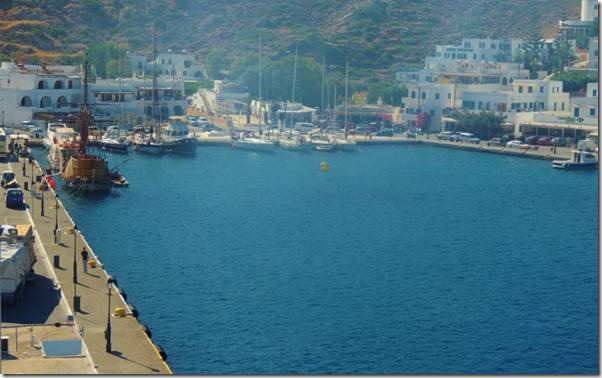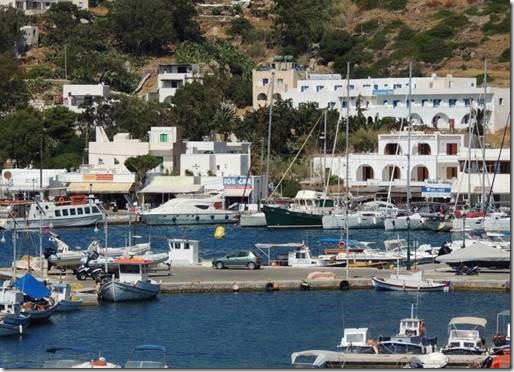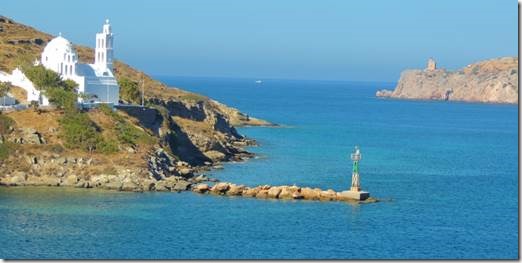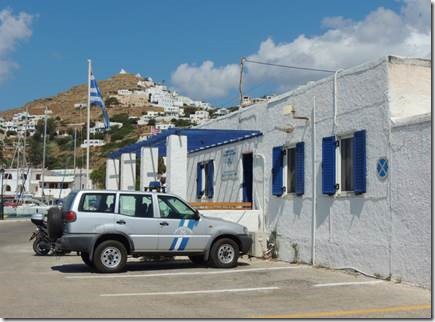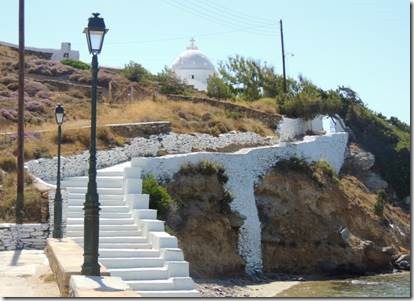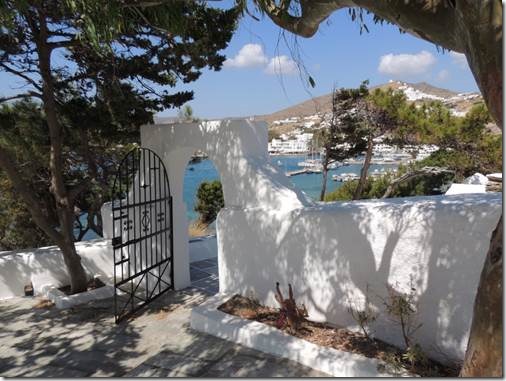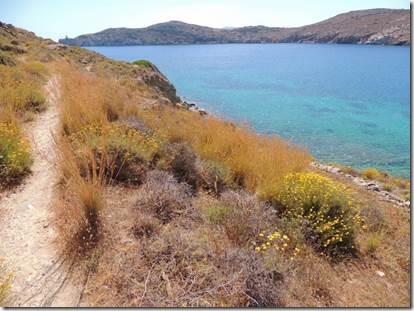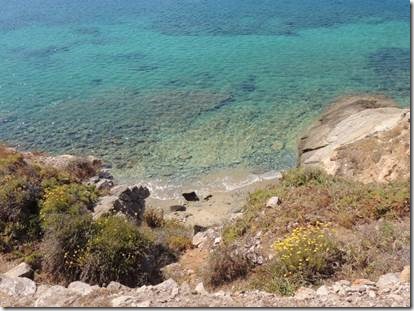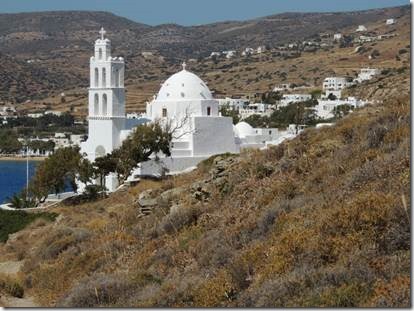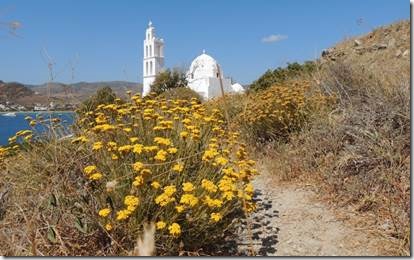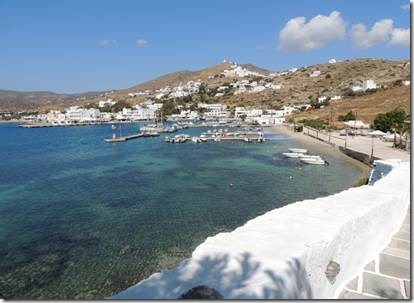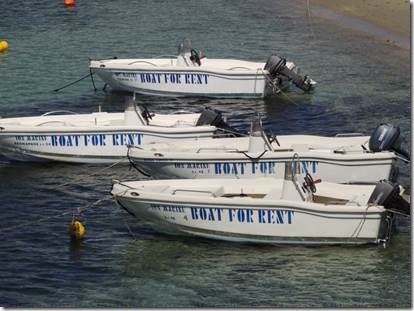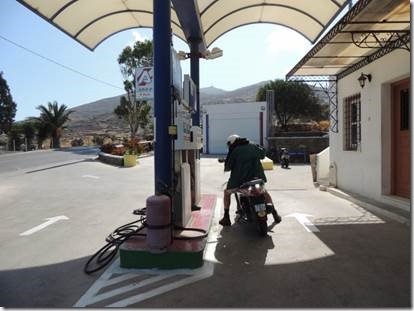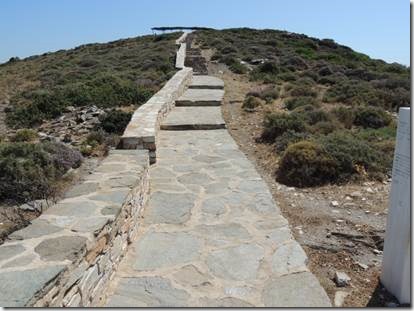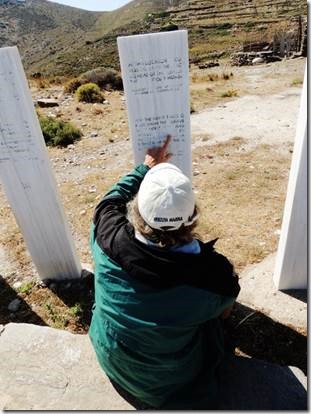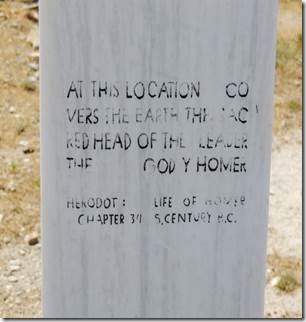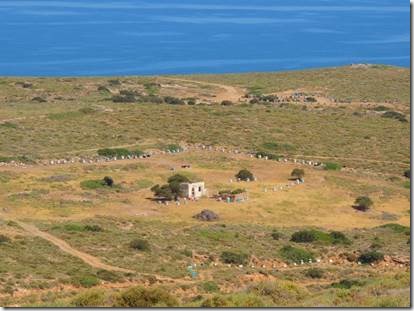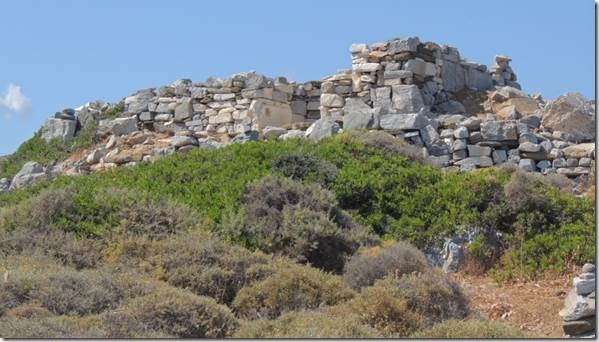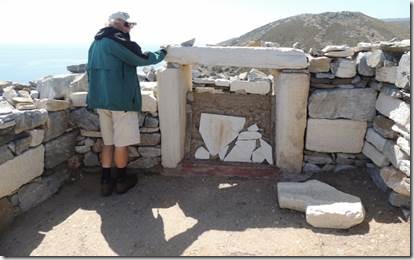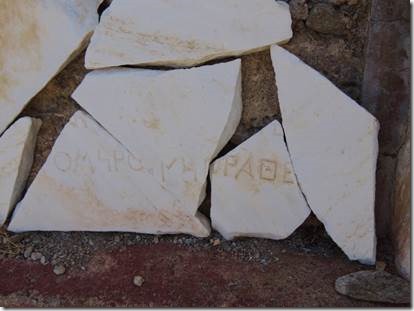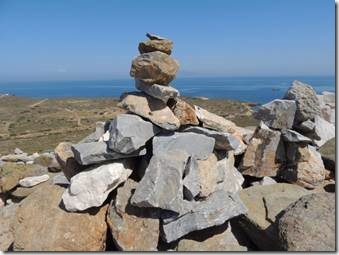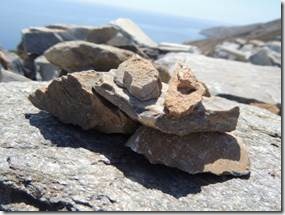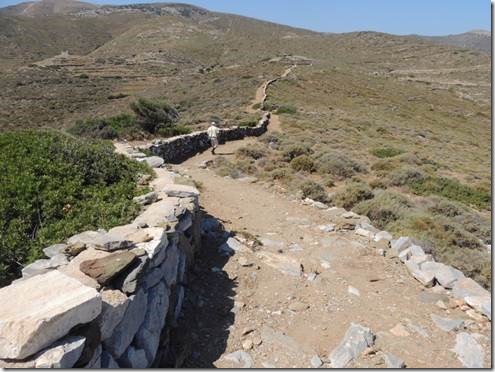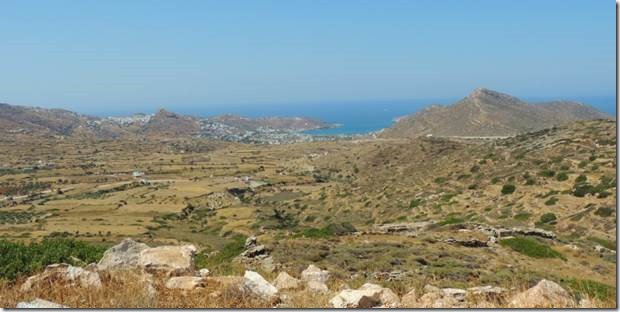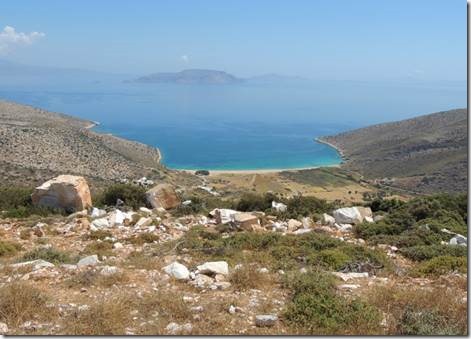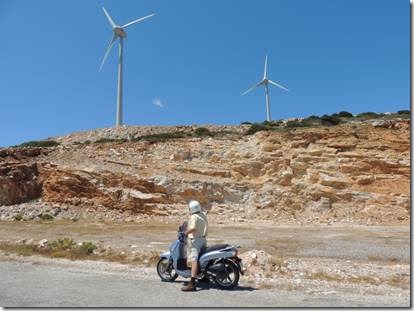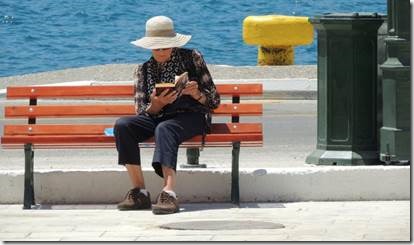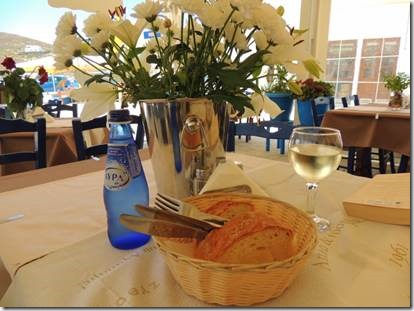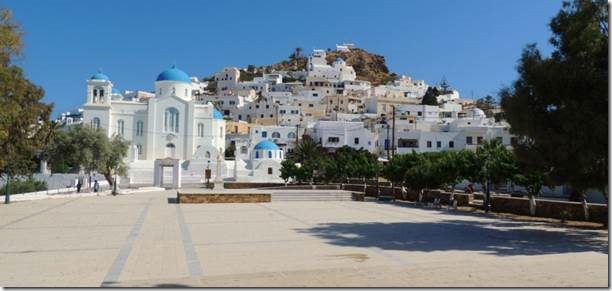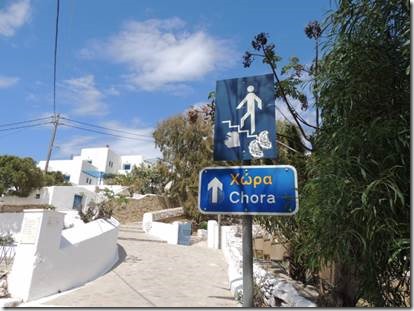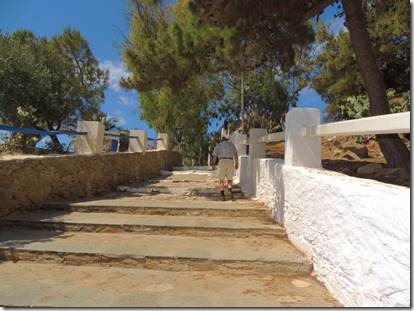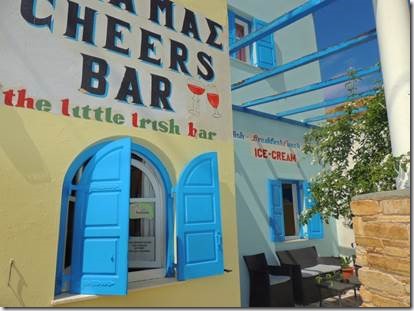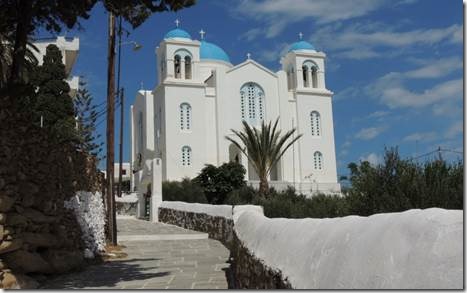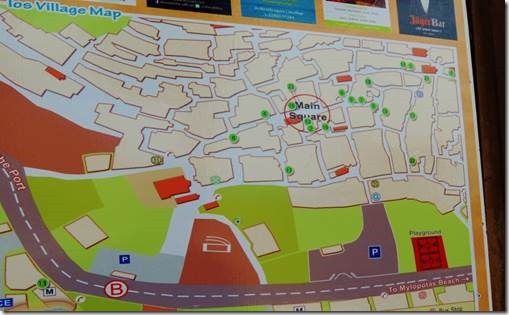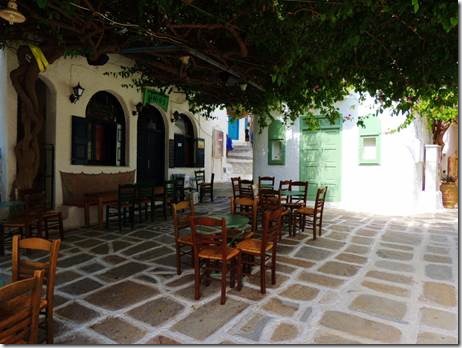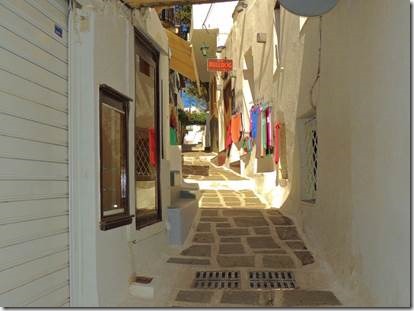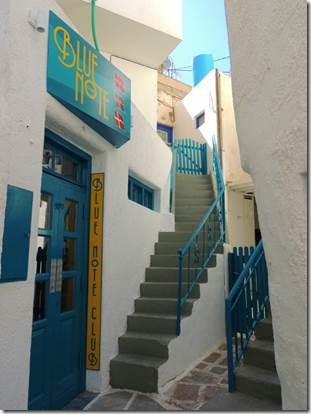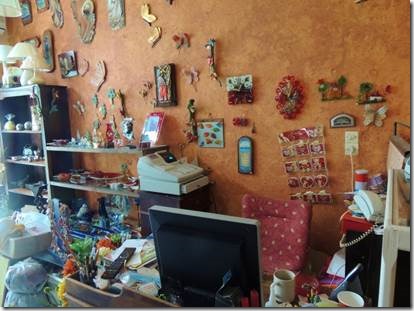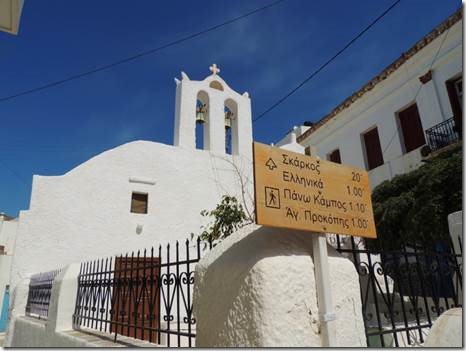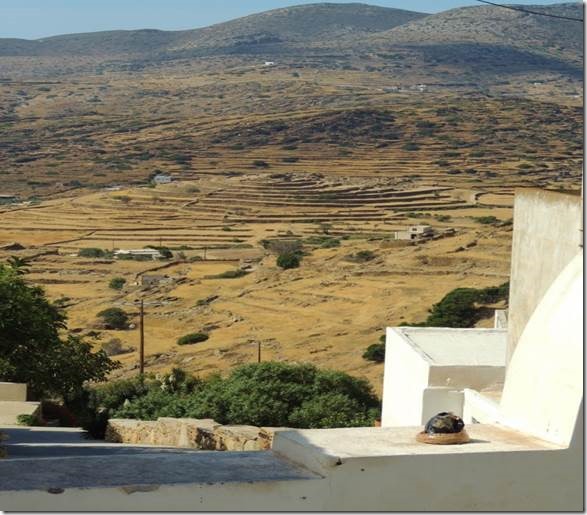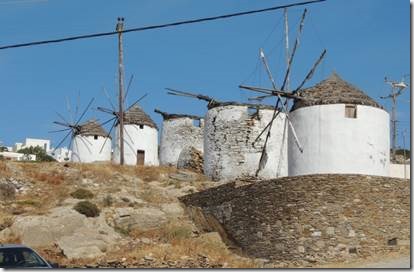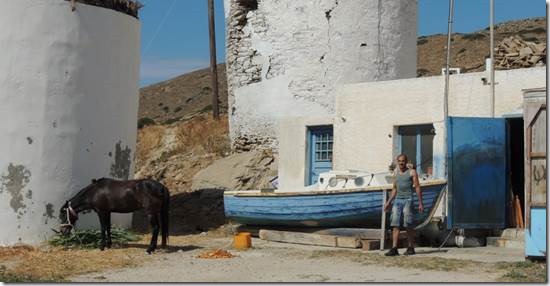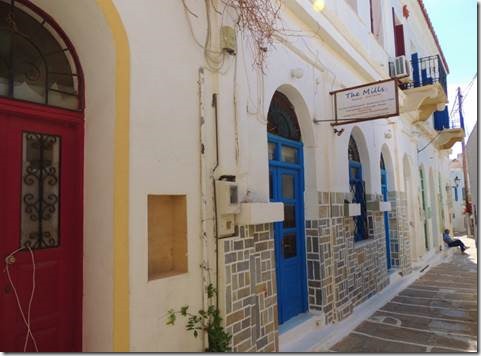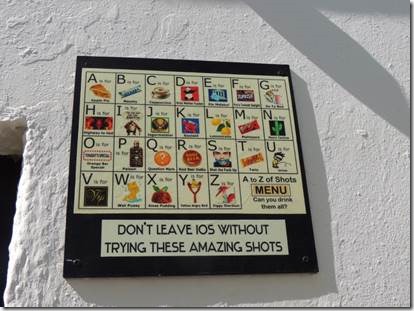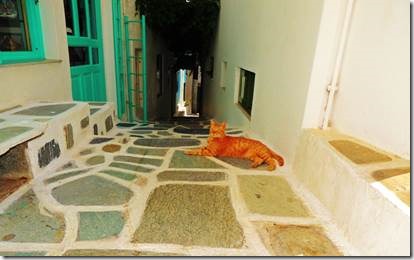|
Ios Chora or Ios Town is the main and only real village of Ios, built on the western side of the island, twenty minutes walk from the Town port. It is a real jewel, built amphitheatrically and shimmering under the sun.
It easily charms everyone with its little cube houses with flat-roofed houses and its narrow stone paved streets winding like a labyrinth of white lines traditionally painted around the large flat stones; arches and arcades are merging from a street or between two houses and contribute to the creation of a wonderful and magical atmosphere.
In this typical Cycladic village, one of the most beautiful town in the entire Cyclades, visitors will find many hotels, pensions, rooms for rent, restaurants, fine jewellery, gift and souvenir shops, mini markets and a great amount of bars and night clubs.
To enjoy the beauty and charms of Chora, it is better to wander around its magical streets during day-light hours, when most of the crowd is lying on the beaches, the bars closed and the locals out of their houses.
The breathtaking view from Panaghia Gremiotissa, the highest spot of the village, is worth seeing and truly unforgettable, especially during the amazing sunset. Behind the beautiful whitewashed windmills is the outdoor amphitheatre Odysseas Elytis (a famous Greek poet), where some concerts and plays are performed during summer.
The ruins of the Venetian castle which lie on the top of the hill and look over the village, are also very interesting to see. Despite the great amount of tourists and the frenetic nightlife, Chora has kept its traditional character and colours, as it has been proclaimed a preserved settlement.
http://www.greeka.com/cyclades/ios/ios-villages/ios-chora.htm
Sightseeing at its peak: My humble apologies if the headline led you to think this particular blog post is about having a good time on Ios while doing illicit drugs! It’s completely understandable if that’s what you assumed, especially considering that Ios has a notorious worldwide reputation as one of the top summer party destinations in the Mediterranean (if not all of Europe, for that matter).
By “getting high on Ios,” I’m actually referring to something totally different: hiking up hills and mountains to enjoy the amazing island views and scenery, and get a natural, physical high.
I got partying out of my system during my university days, so bars, nightclubs, beach parties and boozing it up don’t interest me much anymore. And since I can’t stand being in tightly crowded places, you won’t catch me cramming into Cavo Paradiso or the Space club on Mykonos to join thousands of other people listening and dancing while top DJs from around the world spin music all night long. So why, then, do I even bother going to a so-called “party island” like Mykonos, Ios or Kos in the first place?
Ios is more than just a “party island”
That’s a question I get asked all the time, and my answer is simple: those islands have a lot more to offer besides a thriving social scene. In fact, there isn’t much partying on any of those islands in the spring, which is when we usually visit Greece. If partying is your prime reason for travelling to the Greek Islands, you’ve got to go during July and August, which also happens to be high travel season — the busiest and most expensive time of year to travel in Europe. Many island bars and clubs aren’t even open in May, and the wild beach and club parties you may have heard about generally don’t start before mid- to late June. Until then, the bar scene is rather tame. And come September, once younger travellers have returned to college or university, the party atmosphere quickly dissipates, giving way to a relaxed, mellow vibe that lingers until the tourist season draws to a close in early autumn.
Spring and September are perfect for non-party activities, and sightseeing and hiking are two of our favourites. Actually, hiking is the only way to take in some of the spectacular scenery on islands like Ios because many of the best viewpoints are situated at the tops of hills and mountains that are accessible only on foot (or by donkey, if that’s what you happen to be driving).
Great vantage points abound
At Chora, the main village on Ios, two of the top places to check out the views are from the peaks on the south and north sides of town. The south hill is a short, easy hike above the village, while the peak to the north — the steep rocky mountain crowned by four picturesque churches — is a tougher climb, up dozens of thigh-burning stone steps and along sloping dirt paths. Both points are ideal places to watch a sunset or just enjoy aerial views of the village, surrounding valleys, and the port, harbour and beach area of Gialos.
The top of the hill east of Chora offers two more terrific spots for taking in the scenery while getting some fresh air and exercise. One excellent lookout point is the Giannis Gaitis-Gavriella Simosi Museum of Modern Arts, a huge modern museum & gallery space that opened in 2008 to display work by the late artist Yiannis Gaitis and his wife, but has apparently been sitting vacant ever since. (At least, that’s what several locals told us, and we certainly didn’t see any artwork when we peered through dusty windows into the cavernous empty rooms inside.) From both the big terrace outside the museum and from its wide, flat roof (you can climb a flight of stairs to get up there), you’ll enjoy panoramic views of Chora and nearby Sikinos island to the west. A short walk away is the 1,100-seat outdoor Theatre of Odysseas Elytis, which faces the opposite direction, and offers breathtaking views of Mylopotas beach and bay far below.
http://mygreecetravelblog.com/2012/02/23/getting-high-on-ios/
Ios – The island
Ios Greece or "Little Malta" as it’s called by sailors because its port is protected from the wind.
Ios is one of the southernmost Cycladic islands . The highest mountain is Pirgos, 713m in height, located in the center of the island. The warmest months are July and August (average temperature 28C). although due to the northerly wind called the Meltemi, Ios weather is pleasantly cool.
And there you are, leaning upon the bulwark gazing at the natural harbor of the Aegean and the second most popular area on the island, Ormos,known as Yialos among locals. At the marina, traditional fish boats are leaving for the open sea in the morning and in the evening, fishermen are coming back with their nets full.
Chora, which is situated right next to Ormos, is a typical island town, with Cycladic whitewashed houses that contrast with the blue sky, winding narrow stone paved streets leading to chapels, windmills, and yards. If you take a walk in the evening hours, you will find out that the three main squares are so overcrowded that you may lose your way in the small side streets. The windmills, on the slope above Chora, offer you another good excuse to show off your new camera.
History
According to the tradition,Ios Greece is believed to be the homeland of Homer’s mother, while it is speculated that the great poet died and was buried here.
The island was emigrated by Ions and later became a part of the Athenian Alliance. In the beginning of the 13th century, Ios Greece was conquered by the Venetians who built the castle in Chora the very next century.
Chora
Exploring Chora means, first of all, walking. Choose a cool morning,wear your most comfortable shoes and get ready to set off. One hour is enough for the ones who just want to have a look at this whitewashed village, perched on the slope of the hill between the port and Mylopotas. The more demanding ones will need the whole morning to discover the hidden beauty of Chora. That’s becauseChora was built up for the sun and it’s the sun that reveals the village to the visitor or hides it from him.
To go up to Chora, just follow the wide stone steps of the old ascending road that comes from the port. On your way, right before entering the village, you will come across a part of the walls that once surrounded the ancient town. Following the same road you reach the first square of Chora. To your right stands the modern Orthodox Cathedral of the island, named Evangelismos (Annuciation) and, nearby, a church dedicated to St. Ekaterini, where in 1903 an excavation unearthed the remnants of Byzantine foundations and the ruins of an ancient temple dedicated to Apollo. Above these ruins the Christians built the Byzantine Cathedral,whose altar rests upon two of the temple’s columns.
To your right there is the marketplace and the two main roads that lead you across the village and to the square of the mills. Following the road that goes up, you reach the second square of the village, with its four cafes. On the left side coming from this square, the stone steps lead to the old castle of Chora, where the sublime church of Panaghia Gremiotissa (Our Lady of the Cliffs) is situated, built during the years of the Turkish occupation. According to one tradition, an icon of the Virgin was found among the rocks of Mylopotas’ seashore, with a lit candle standing on it. The legend has it that the inhabitants of Crete had thrown the icon in the open sea to protect it from falling to Turkish hands, and that the waves had carried it to that coast. The icon was then taken to the church of the HolyCross, but only to be found again the following morning on the same steep mountainside. When the islanders tried to build a new church for the icon, but not on the exact spot where it had been foundbecause of its inaccessibility, the foundation stones of the church kept disappearing every day in a miraculous way.
It was only then that the islanders understood that the icon had chosen that exact spot, because it was the only one from where the dim shape of Crete could be viewed. On this piece of rough land they built the new church, known today as Gremiotissa, with its miraculous icon. A little beyond this church you can see the ruins of the castle walls and enjoy the magnificent view of the port and of Vigla. If you walk towards the northern side of the castle, you will come across the ancient walls again. On the other side of the market area, the square with the old windmills is a centre of commercial activity and a meeting place for the local festivals. Today, because of a complicated system of private ownership, the square remains undeveloped, used only as a parking space, but we hope that the efforts of the local authorities will soon pay off, so that the inhabitants and the visitors will have the opportunity to enjoy the fantastic view from a reorganised square. From the square of the mills, you can follow the narrow street that goes up to Prophitis Elias. A path of 500m., with magnificent view to Chora and to Mylopotas, leads you to the church of Prophitis Elias. In periods of water shortage, a procession with icons and banners is made along this path towards the church. http://www.ios-maganari.com/eng/ios_eng.html
|

